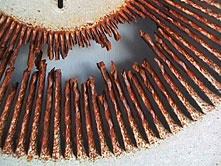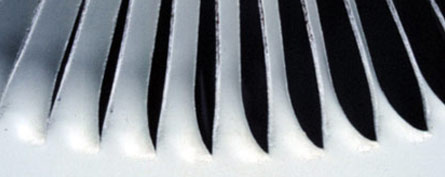Cutting Edge of Corrosion Resistance
Even with exposed cut edges, prepainted metal outperforms post-painted parts. Yes, really. We’ve done the study to prove it.
Prepainted metal louvers with exposed cut edges were tested in the field against post-painted metal louvers, one with an electrocoat, a second with a powder finish, and a third with a spray finish. The parts in all instances were made of hot dipped galvanized steel and louvers were exposed to the same environment over time in Daytona Beach, Florida.
After 16 months, 44 months, and 68 months of exposure to the elements, comparisons showed the prepainted parts were repeatedly and significantly more corrosion resistant than the post-painted parts.
Experts agree the reason that the prepainted parts outperformed all three post-painted parts is that prepainted metal sheet is uniformly cleaned, treated and painted as a flat surface, so the edge to edge and side to side variability is virtually eliminated, and imperfections and dirt are all but eliminated from the coating. In addition, the prepainted part has two coats of paint, tightly bonded to the metal as compared to a post-painted part, which generally has only one coat of paint. Also, in most cases, the prepainted part has paint on the backside – not just the front. Post-painted parts at best have a small amount of overspray on the back. Thus uniform precleaning, pretreatment, and prepainting increases the corrosion resistance of the part, enhancing long-term durability.
The study findings conclude that with proper selection of paint and substrate, a prepainted part should provide a superior, cost-effective product in corrosion resistance, appearance, and durability as compared to parts painted using other paint application methods.
 | 
|
| Prepainted Metal with Cut-edge, after 5 Years | Post-painted Metal with Cut-edge, after 5 Years |



